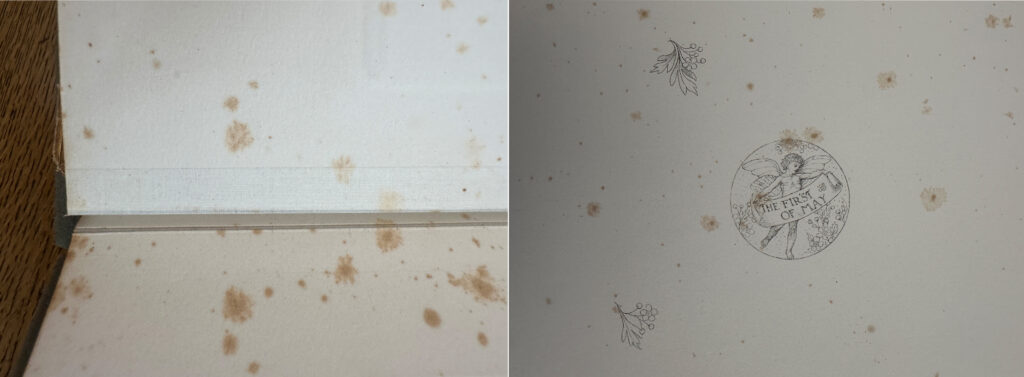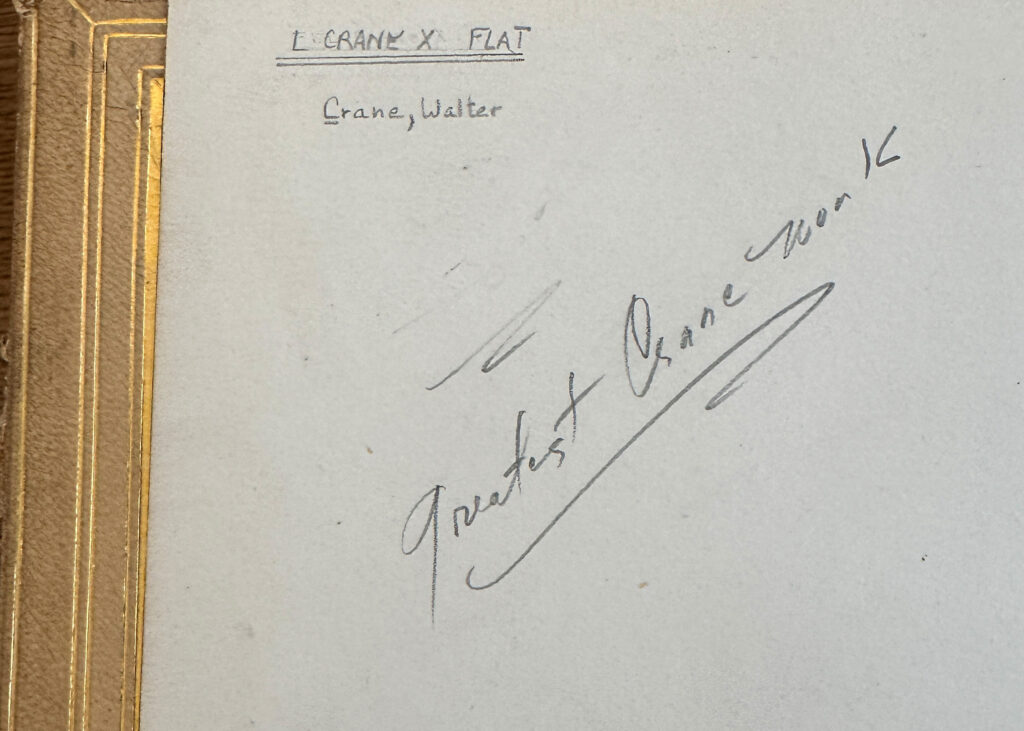After pondering and speculating about The First of May it’s time to think about what kind of life this book had. The binding of the copy Wesleyan has seems in pretty good shape — even though there are a few scratches on the leather cover and acidic (?) spots in most of the pages. According to WorldCat, there are 64 copies of The First of May in libraries around the world, interestingly enough most of them are in the United States. There are also a couple of copies for sale at antiquarian booksellers.

To think about the life of a book I thought it would be really interesting to trace its origins first — which started when John R. Wise received a fortune through the death of his uncle and decided to publish a play he had written. In 1878 he asked Walter Crane to illustrate it and proposed to publish as an illustrated gift-book. Crane joined Wise in a forest lodge a couple of times so Crane could sketch the designs for The First of May. About creating the illustrations Crane wrote in his book An Artist’s Reminiscences (1907):
“…there were many pages, and each page had a decorative border and figure design upon it, while the whole of the text I inscribed to be in harmony with the designs. The drawings were made in pencil, and were afterwards reproduced by photogravure by Messrs. Goupil & Co., the plates being done in Paris.”
Wise was well aware of the amount of work he asked from Crane — and the amount of money it would cost to produce a book of such quality. In the Summer of 1878 he wrote a letter to Crane expressing his feelings about the production of the book:
“My Dear Crane,
…
I have great misgivings about the success of The First of May, even should it appear under your auspices, and feel unwilling that you should risk your reputation over such a hazardous enterprise.
I have had the enjoyment of writing it, and that is after all sufficient for me.
…
P.S. — Remember I think nothing about my play. It can well afford to wait ten years before it is published, as it has waited so many. Let this be your last concern.”
It took a couple of years for the illustrations to be done, when in 1881 The First of May was finally published. Despite the costs of the book, Walter Crane got a few copies from John Wise to give as presents to his friends. Crane received many thank-you and congratulatory letters, one of them being from the English painter, E. Burne Jones:
“My Dear Crane, — What a gift! Only kings send such presents to other kings — is it possible that we are after all in that category? But it is a splendid book, and will be a great treasure to me, and one of my chief possessions, and how can I thank you enough? I hope the whole country will be as grateful as it ought to be.”
And another one from painter and sculptor William Blake Richmond:
“My Dear Crane, — To express in terms that would not appear extreme, alone could I acknowledge and thank you for the most valuable and lovely gift. From page to page, fancy is led on, the design is the more beautiful that the previous one, more precious in sentiment and more lovely in execution.
…
Thank you, my dear brother painter, for your gift and accept my very sincere congratulations on the exquisite results of your labour.”
The First of May was a success among his peers.
The pet book project made me reflect a lot about the importance of books and how they affect our lives in all kinds of ways. A book can exist physically or in our minds — for as long we live. Many copies of The First of May survived and remain whole being available for sale through book dealers. Which makes me think that the book was considered a prized possession for the original owners. It was for sure special to me to hold a book — almost 150 years later — that Walter Crane held himself to sign it. Besides thinking about the proposed questions for the project, this book took me to many places, made me curious enough to research Crane’s life, his socialist ideals and the Arts and Crafts and the labor movements. But I still have many unanswered questions. I wonder who owned this one and the other copies? Were most of them gifted to friends of the author and the artist? Was The First of May a type of coffee book after all? Or a collectors’ item? One thing is true: this book probably had many afterlives — including the one I’ve imagined for it.

Bibliography
Crane, Walter (1907). An Artist’s Reminiscences. London: Methuen & Co.
